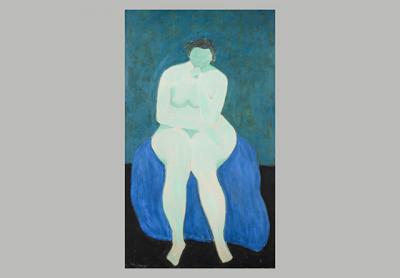Albee Auction To Help Foundation

While it is unlikely that anyone will ever replicate the perfectly assembled mix of ur-modernism that Edward Albee achieved with his collection of paintings and primitive sculptures, those who might want to try can bid on the sale of his estate on Sept. 26 at Sotheby’s in Manhattan.
The playwright, who died last September, directed that the sale benefit the Edward F. Albee Foundation in Montauk, which provides residencies for writers and artists. The Pulitzer Prize and Tony Award-winning author of such seminal works as “The Zoo Story” (1958), “Who’s Afraid of Virginia Woolf?” (1962), “A Delicate Balance” (1966), “Three Tall Women” (1991), and “The Goat, or Who Is Sylvia?” (2000), started the foundation in 1967 from the proceeds of “Who’s Afraid of Virginia Woolf?”
In the auction catalog, Jakob Holder, executive director of the foundation, writes that Albee was taken to Montauk in 1964 by the actress Uta Hagen, the original Martha in “Virginia Woolf.” He bought a cottage on a bluff and a barn, which would become the William Flanagan Memorial Creative Persons Center, named for a partner of his. He renovated the space to include two studios and five bedrooms. Some 1,000 artists and writers have since been granted one-month summer residencies there.
Albee had a wide circle of artistic friends, including Lee Krasner, who served on the board of his foundation. The more than 100 artworks in the auction are from his TriBeCa loft, and fulfill his vision of “art that is about art.” They include pieces by Krasner, Wassily Kandinsky, Jean Arp, Kurt Schwitters, Jack Youngerman, Milton Avery, Pablo Picasso, Richard Serra, Marc Chagall, Elizabeth Murray, Saul Steinberg, Louise Nevelson, Donald Sultan, Esteban Vicente, Alfred Leslie, and John McLaughlin, in addition to several African and Oceanic sculptures, which inspired many of the earlier modern artists.
Mr. Holder writes that Albee thought of his collecting as “accumulating” — satisfying a primary utilitarian function — “to satisfy his desire to successfully communicate in ways where humans are prone to fail.” Not a casual observer, he chose challenging objects that he also deemed useful. “The merely decorative held no interest.” He tended to cultivate works of art the way he chose his friends.
Sotheby’s has compiled some of Albee’s musings on art: “There is something that makes something art. It doesn’t have anything to do with anything except the piece itself.” Sculpture, he said, “mutates faster than any other art form I know of.”
A fan of Milton Avery, Albee began collecting his work directly from the artist when his paintings were still affordable. Avery’s “Two Nudes,” a work that inspired Albee to go “industriously back to my desk to write another play so that I could get some more,” has an estimate of $400,000 to $600,000. “Meditation,” a painting of a seated nude woman, is expected to fetch $2 million to $3 million.
Some works, like an early Jack Youngerman collage, have local provenances from galleries such as the Drawing Room in East Hampton. The 2013 purchase is evidence of an eye that was always searching and finding things to acquire.
Albee was not known to sell things from his collection, but Bill Katz, a friend, relates in the catalog that he once had to sacrifice a large Henry Moore bronze that graced the Montauk property to settle a tax debt. Mr. Katz says the playwright did not buy art as an investment, but understood that many of his pieces were of significant value and worth selling to ensure the future of his foundation. Works not in the sale will become part of the foundation’s collection.
Although there are clear multimillion-dollar masterpieces in the mix, the bulk of the Albee sale consists of more moderately priced small pieces or works on paper, many with estimates below $5,000. These include works by Burgoyne Diller, Vicente, Nevelson, and some Picasso etchings. Objects in the five-figure range include a Frank Lloyd Wright window and a Tiffany chandelier, in addition to several artworks. The catalog is on the Sotheby’s website.
Works from the sale will be on view from Sept. 20 to Sept. 25 from 10 a.m. to 5 p.m.
